White gold is one of my favourite precious metals and natural, unplated white gold has become one of my client’s most popular choices for their for bespoke jewellery. However natural white gold is not something you see on the high street, where white gold appears to look the same as Platinum due to it having a thin layer of Rhodium plating. This disguises the white golds’ natural colour, making it look like Platinum but with a less scary price tag (9ct white gold at least – 18ct is around the same price, if not slightly more expensive than Platinum at the time of writing). Those who buy a white gold piece of jewellery will find it soon develops a ‘discoloured’, ‘yellowy’ patch where it wears most. This can ‘tarnish’ (excuse the pun) the whole experience, spoiling the enjoyment of purchasing a special piece of precious jewellery.
What I would like to encourage is Rhodium-free gold!
White gold does not have to be rhodium plated. Historically, white gold was plated in Rhodium because the first white gold alloys were not very successful. However the 9ct and 18ct white golds available are a lovely colour that does not have to be plated to appear white in tone. Yes, if you compare natural, non-plated white gold side by side to Palladium, Platinum or Rhodium plated gold, you will see a difference. But individually, natural white gold will appear white. 9ct white gold has a slightly creamier, golden hue. 18ct white gold is darker, almost gunmetal in tone. Both these warm white tones can suit a lot of skin tones better than the chrome like, cool white of Platinum, so it is always worth trying them all on before making your final decision on metal.
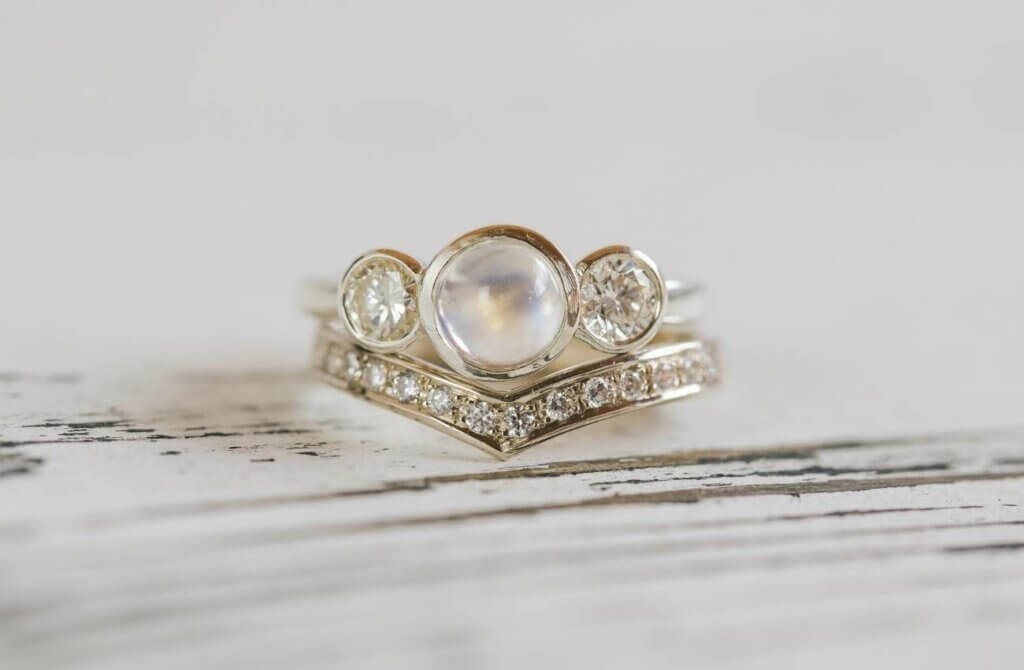
Back to basics
To truly understand the issue of Rhodium plating, you need to understand the make-up of white gold. In its natural form, gold is yellow, period. It is rarely made into jewellery in its natural state because it is just too soft. Gold is discussed in terms of 24 parts (or carats) and is always made into an alloy (a combination of metals), usually seen in 9 or 18ct in the UK. This means that the ratio of the alloy is 9 or 18 parts gold mixed with other metals to ascertain desirable strength and colour properties.
If the other metals in the alloy are mostly copper or silver, then the gold will remain yellow in colour. If the other metals are Palladium in the UK, or a mixture of Palladium and nickel in the US, then the resulting alloy is bleached to a white tone.
As so many people are allergic to nickel, Rhodium plating was introduced to provide a barrier between the white gold and the wearer’s skin. All white gold jewellery in the UK is now nickel free, but this is not the case in the US. This means that white gold jewellery made in the UK is more expensive than the US because the alloy is made up of more expensive, but much less reactive, metals.
Rhodium is the most dazzlingly bright white precious metal that exists; it suits the contemporary taste for a chrome-like sparkle. Because the colour of Rhodium is so close to the icy white of diamonds, it is hard to see where diamonds end and the metal begins, therefore making the stones appear larger.
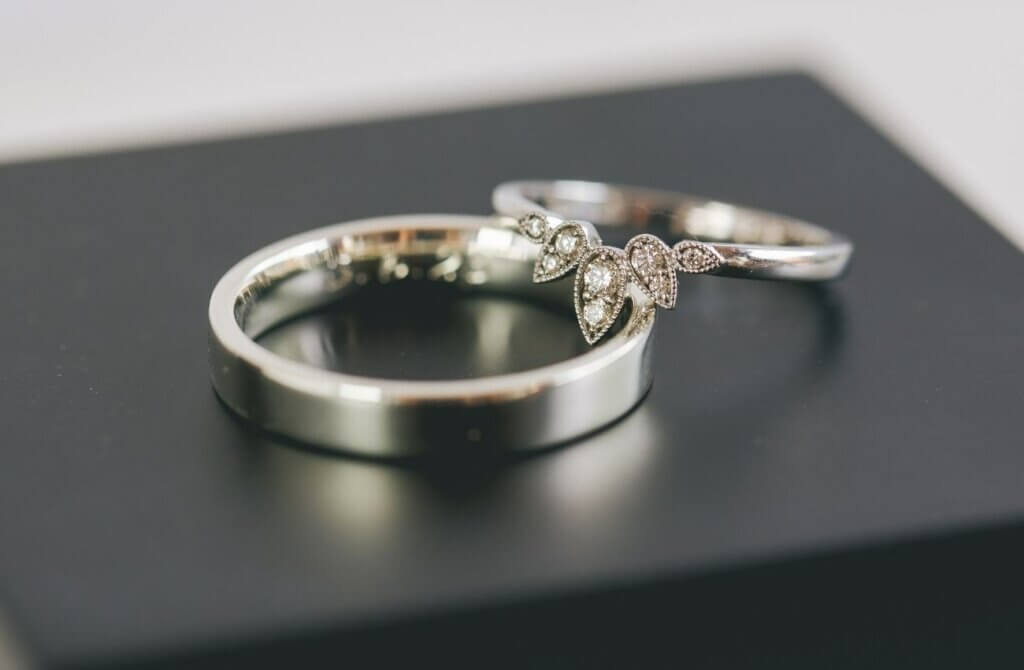
However…
I have three main issues with the concept of plating metals:
- Firstly, in my opinion, natural materials age far better than those which have been covered up and altered by man.
- Secondly, the process is incredibly toxic to the environment.
- Finally, to Rhodium plate gold means regular visits to the jewellers to have the piece re-plated, so you are without your beloved jewellery for however long the jeweller takes to do the process.
1. The ageing process
Rhodium plating is often advertised as a tough coating for your jewellery, which will help to protect it from knocks and scratches. It is true that Rhodium is a tough metal, so much so that it is not considered feasible to make into jewellery because it is so brittle. But let’s get this clear: precious metals are not hard wearing or particularly durable, especially not in comparison to manmade metals such as stainless steel. And anyway, plating is only ever microns thick – hardly a protective armour for your beloved jewellery!
Rings are the most at risk for wear and tear as they come into contact with everything your hand does. Door and drawer handles, cutlery, sinks, pots and pans, tools… they are all made of much tougher metals. When your ring hits these, it will leave a mark or wear down the surface of the metal. If the ring is plated, then the plating will wear over time, revealing the true colour of the metal beneath. This ‘discoloured’ patch, in a side-by-side comparison to the cold white of Rhodium, will look very yellowy.
I think the best analogy for the ageing process of plated metal is found in architecture. Buildings made of natural materials such as stone age gracefully as they soften into their environment. Compare that with a brutalist concrete monstrosity and there is no comparison. Concrete will stain, crack and darken; manmade materials age quickly and far less charmingly.
The same goes for jewellery. White gold will burnish over time, collecting a patina of marks and fine scratches that document the life of the piece. Put plating on it and it will wear in patches where it receives the most knocks, and not in a nice way. The contrast between the true colour of the gold with the bright Rhodium will make the gold look anything other than white. Leave it natural, and it will look ‘white’ and age better.
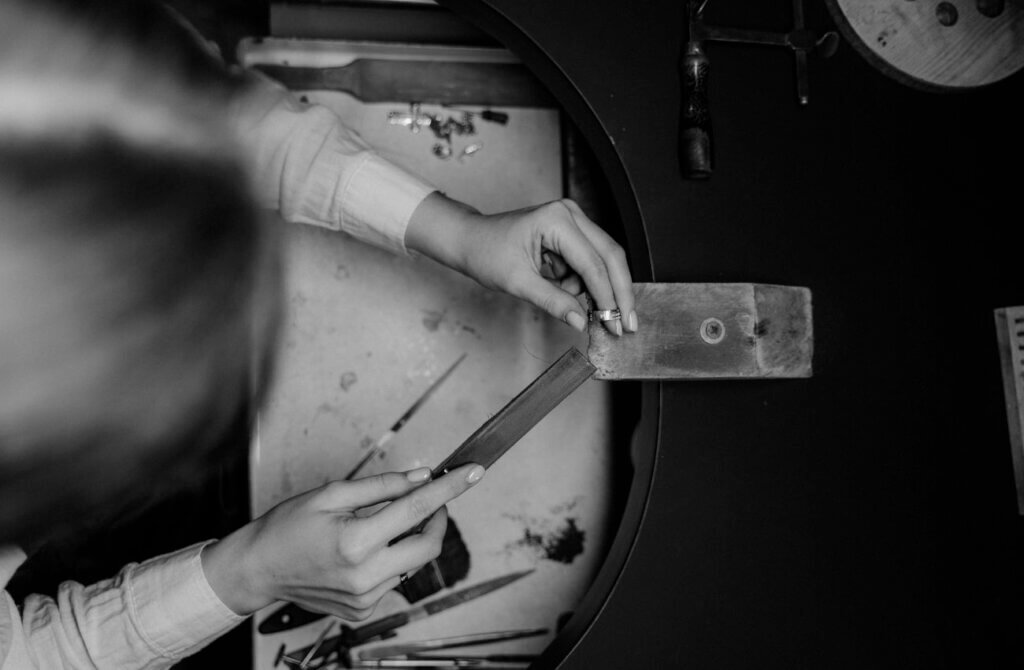
2. The true cost of plating
By the cost, I don’t just mean financially, but the value of Rhodium is incredibly volatile. It is a by-product of Platinum mining and, therefore, is priced depending on availability. Rhodium is an incredibly rare and precious metal, which can cost ten times as much as gold if not more! But it can also cost the environment dearly.
Most commonly, the electroplating process is used so don’t be fooled by the term ‘dipping’. This is a phrase high street jewellers are very fond of as it conjures images of your jewellery being dipped into a vat of liquid glistening and bright white metal. While your piece of jewellery is dipped into a liquid, this liquid is actually a heated tank of Rhodium sulphate, sulphuric acid and water. An electric current is run through the jewellery, which acts as a cathode or negative electrode so that the rhodium particles are attracted to it, forming a permanent bond between the metals. The resulting effect is a micron-thick coating on the outside of the jewellery. Does this not raise the question of whether the base metal needs to be gold in the first place? When the solution is finished with, it then needs to be disposed of which raises obvious environmental issues.
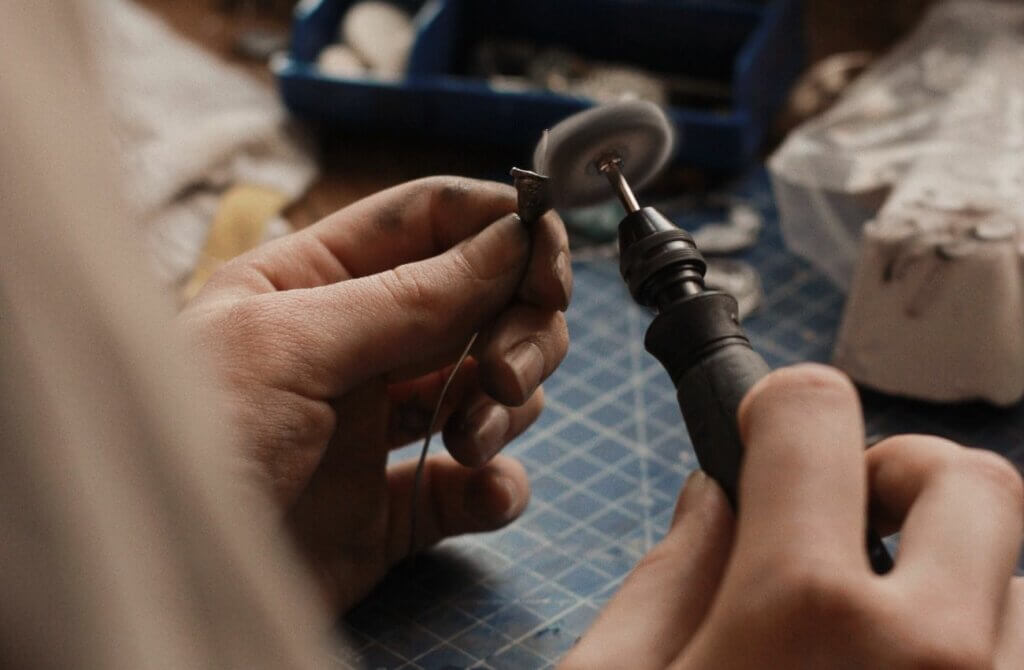
3. Time and inconvenience
So you’ve been presented with a beautiful piece of white gold jewellery. Do you really want to part with it as a regular occurrence while a jeweller re-plates it for you? It is not a quick process as the piece of jewellery has to be scrupulously cleaned and re-polished beforehand. A worn piece of jewellery will be grubby and so will not plate well. It must be considered that every time jewellery is polished, you will lose metal. To polish metal is essentially to scratch the hell out of it, thus wearing away the surface and gradually thinning it out.
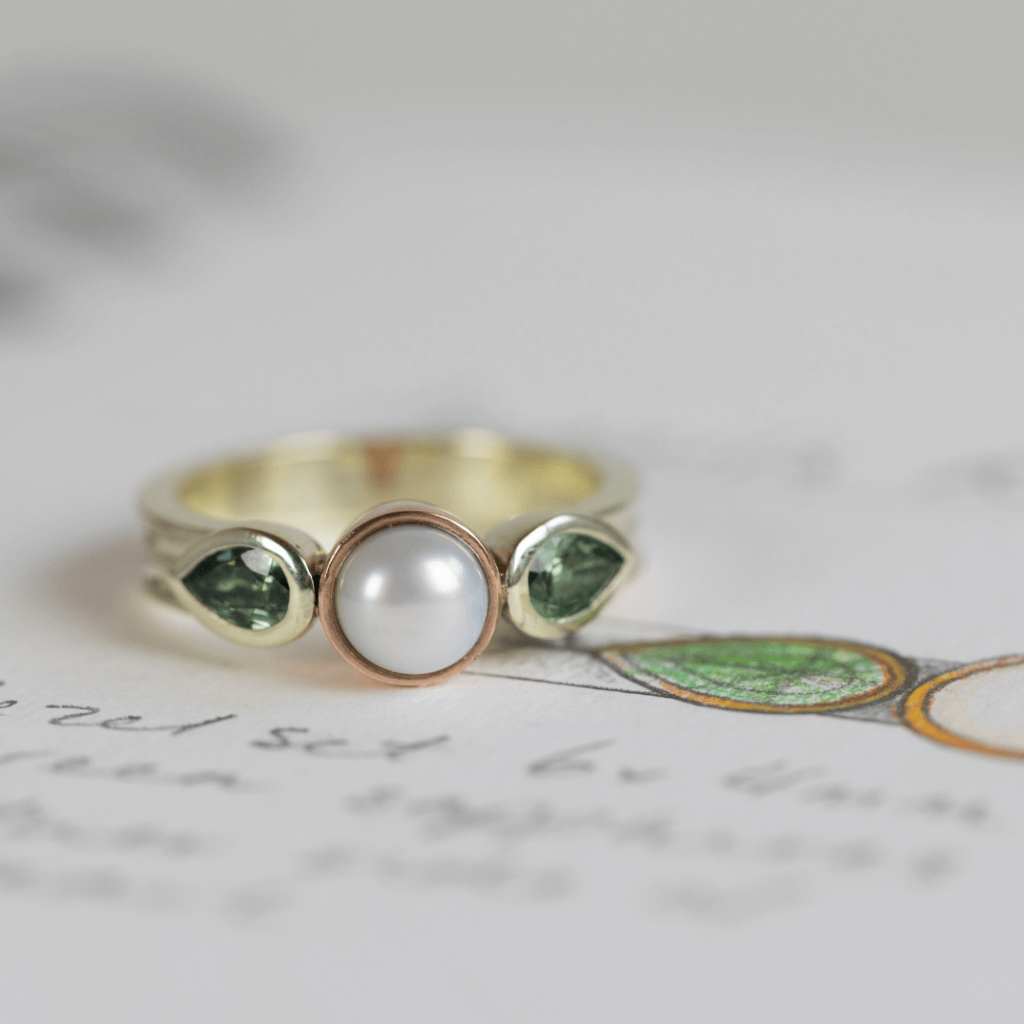
The plating on rings will wear really quickly but pendants and earrings will take a lot longer as they are not battered on a day to day basis with general wear and tear. How quickly it takes to wear depends entirely on your lifestyle; we’re talking anything from 6 months to two years. Before opting for Rhodium plated white gold, you do need to think carefully about whether you are willing to take your jewellery in to be re-polished and plated on a regular basis for it to be looking its best.
And here is one I made earlier…
Here are some of my designs featuring natural, un-plated white gold in all its natural glory to showcase this beautiful metal.
Tom and Jordan’s 9ct White Gold Engagement and Wedding Rings
The crisp, cool whiteness of the diamonds in Jordan’s engagement ring stand out from the metal because of the slight contrast in their colour, rather than the stones disappearing into the metal.
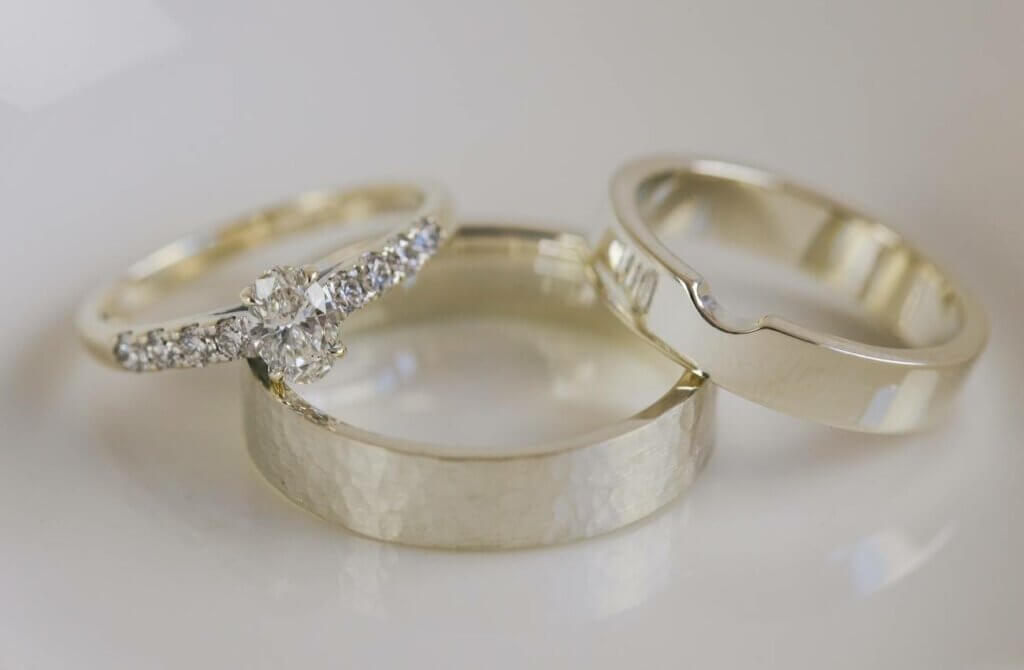
Natural, Creamy 9ct White Gold
Sam’s memorial ring used some elements of yellow gold from her mum’s jewellery, but as she usually wears silver jewellery, she wanted the ring to be white. She opted for white gold, and took a leap of faith when I advised her to keep it natural and un-plated. Sam absolutely loved the end result and the softer tone of the metal when it is not plated.
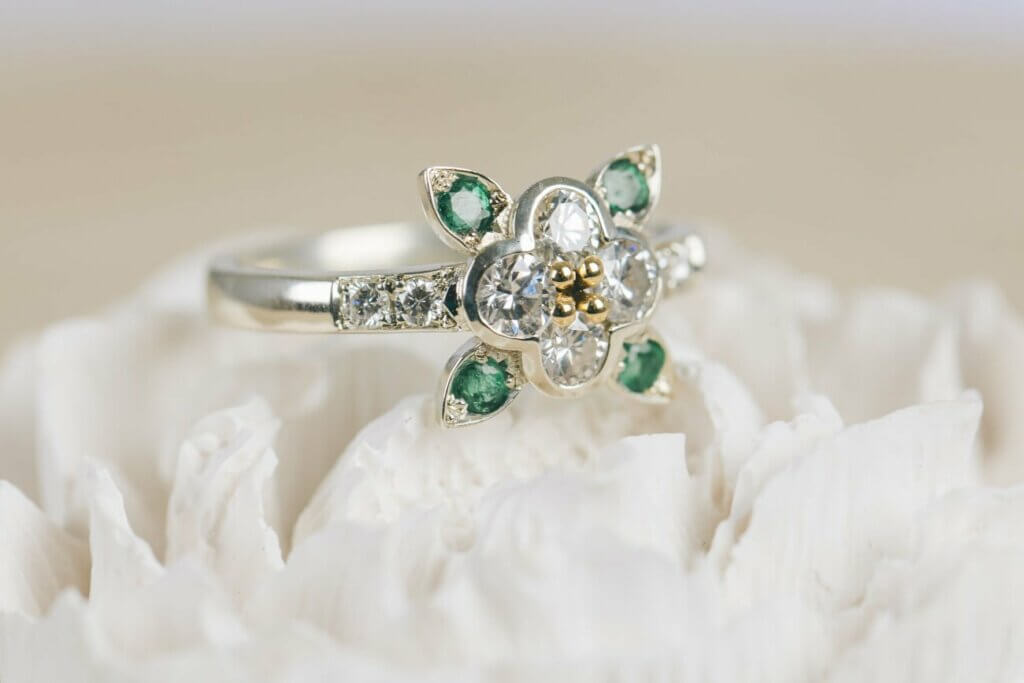
White and Rose Gold
I love the mix of texture, finishes, metal and stones in this ring. The custom rose cut peridot is just beautiful, and contrasts so nicely with the diamonds. The white diamonds stand out from the textured white gold due to the metal having a slight warmth to it. The soft warmth of the white colour perfectly suits the softness of the design and organic lines.
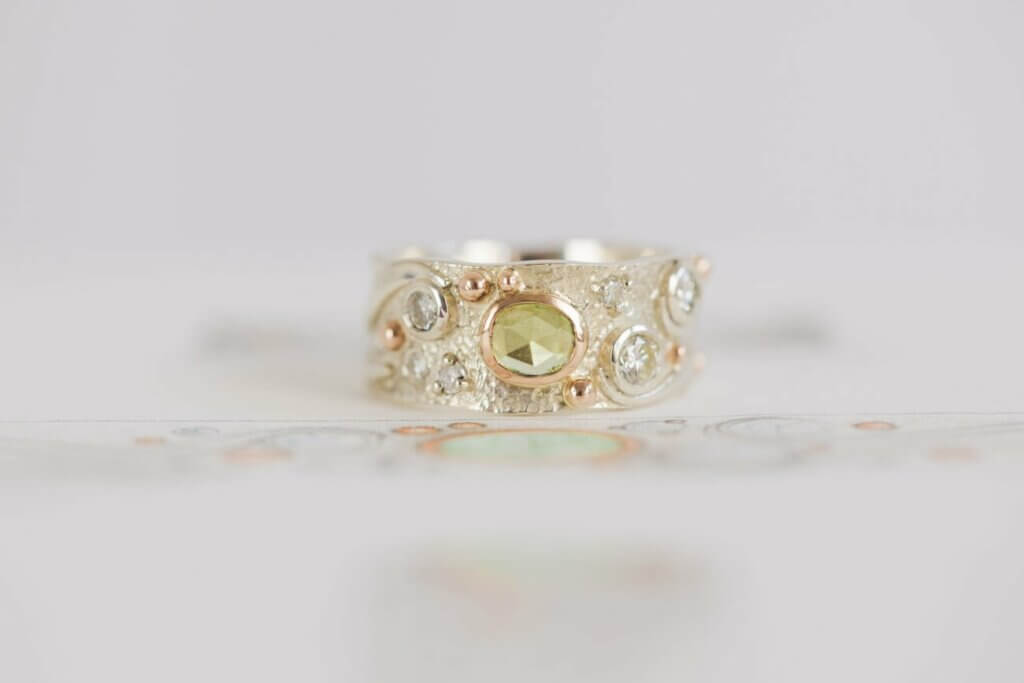
Natural 18ct White Gold Engagement Ring
Jonty had done some research online and discovered a love for natural white gold when looking into finding the perfect engagement ring for Connie. He was disappointed not to find any option for un-plated white gold on the high street, and so bespoke was the perfect route for him. She loved this choice and went for the same for her fitted wedding ring. The effect of the darker white gold against the crisp white stones makes a real feature of the design.
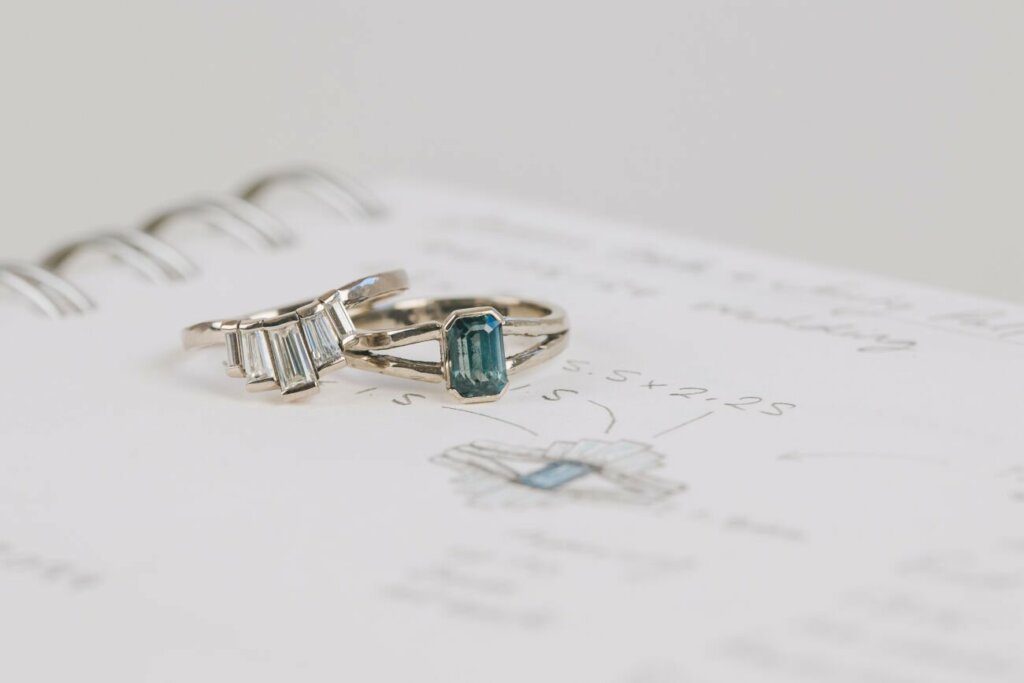
Emerald and Diamond Eternity Ring
Sarah’s eternity ring is made from natural 18ct white gold to complement her wedding and engagement rings where the rhodium had worn away over time. She loved their natural warmer tone and so embraced this with her new ring.
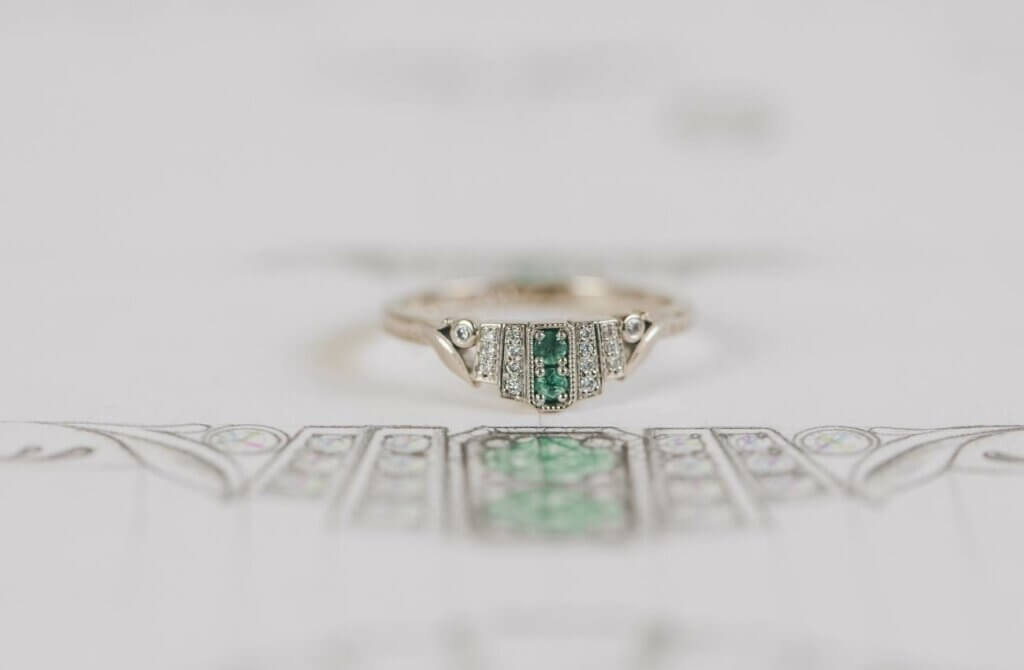
Natural 18ct white gold with Rose Gold
I adore this engagement ring! The warmth of the white gold contrasts very slightly against the crisp whiteness of the diamonds so the metal doesn’t just blend into the stones. The warm white gold feels so natural paired with the rose gold band too.
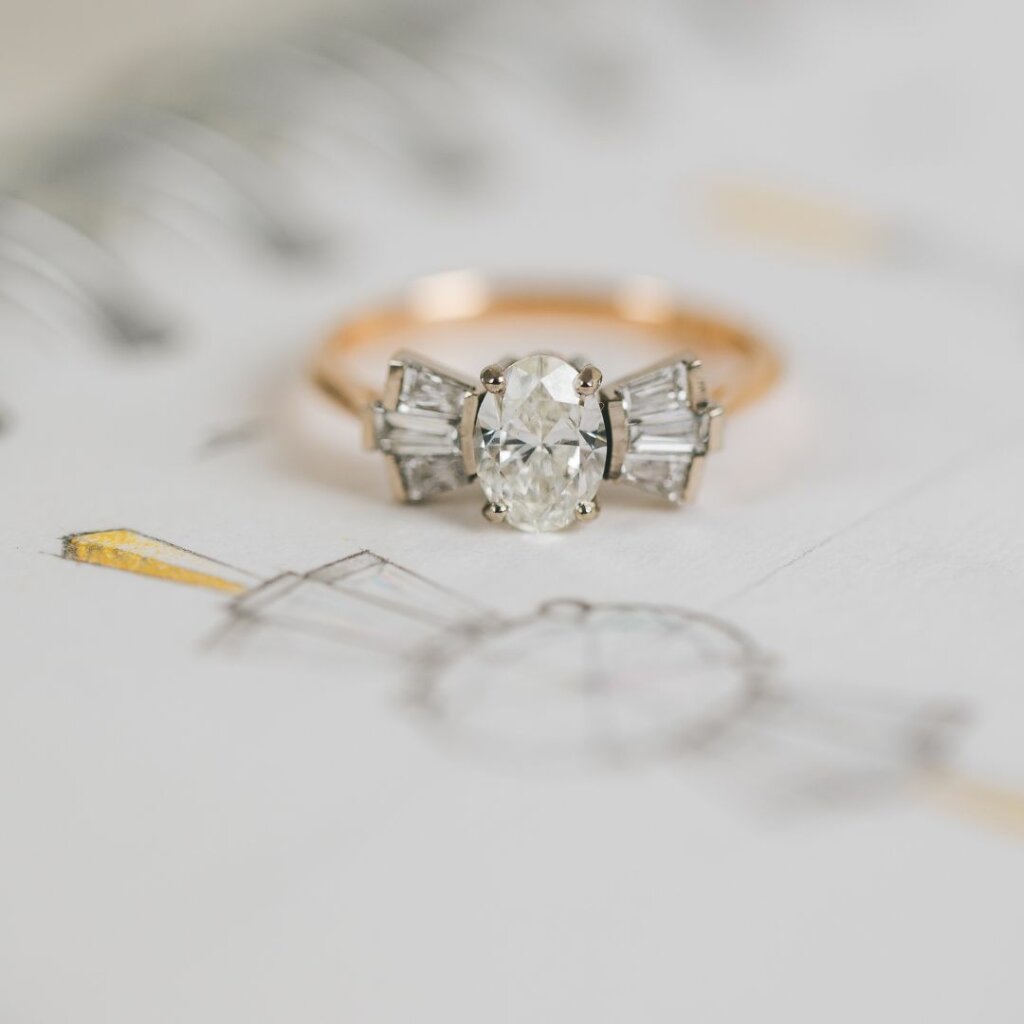
18ct White Gold Inlaid with Whitby Jet
Dom and Emily fully embraced the bespoke journey with their wedding rings and loved learning about natural white gold in our design consultation. We polished the remaining rhodium off her engagement ring and made their wedding rings in the same, natural white gold, but inlaid with Whitby Jet in honour of their first date in Whitby.
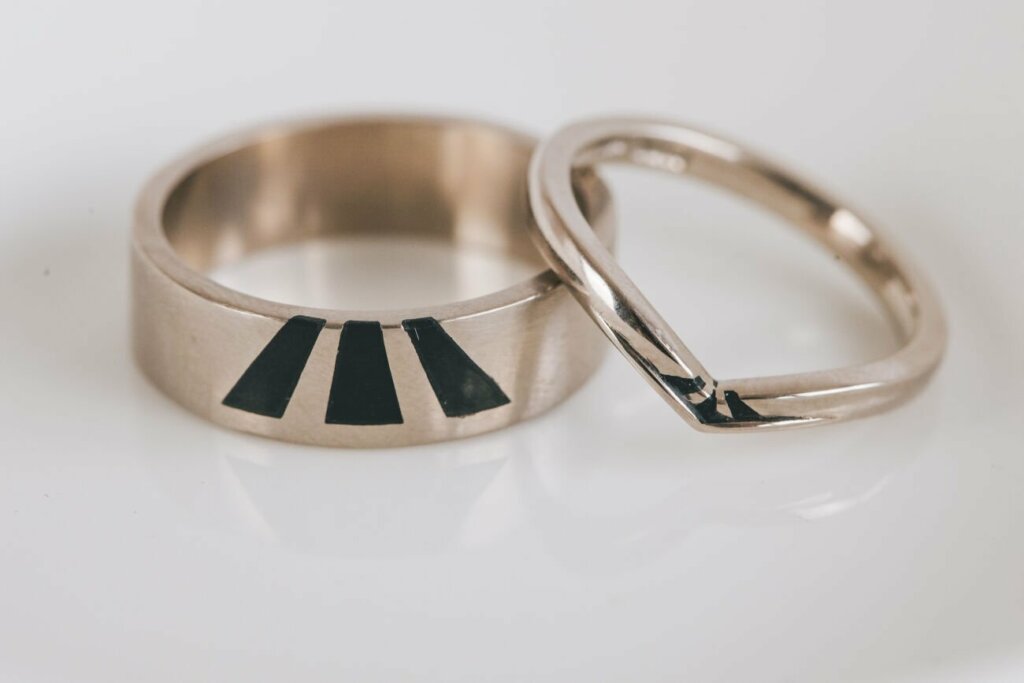
9ct and 18ct White Gold Wedding Rings
Lewis and Colette’s natural white gold wedding rings showcase the difference in tones between the two qualities of white gold perfectly.
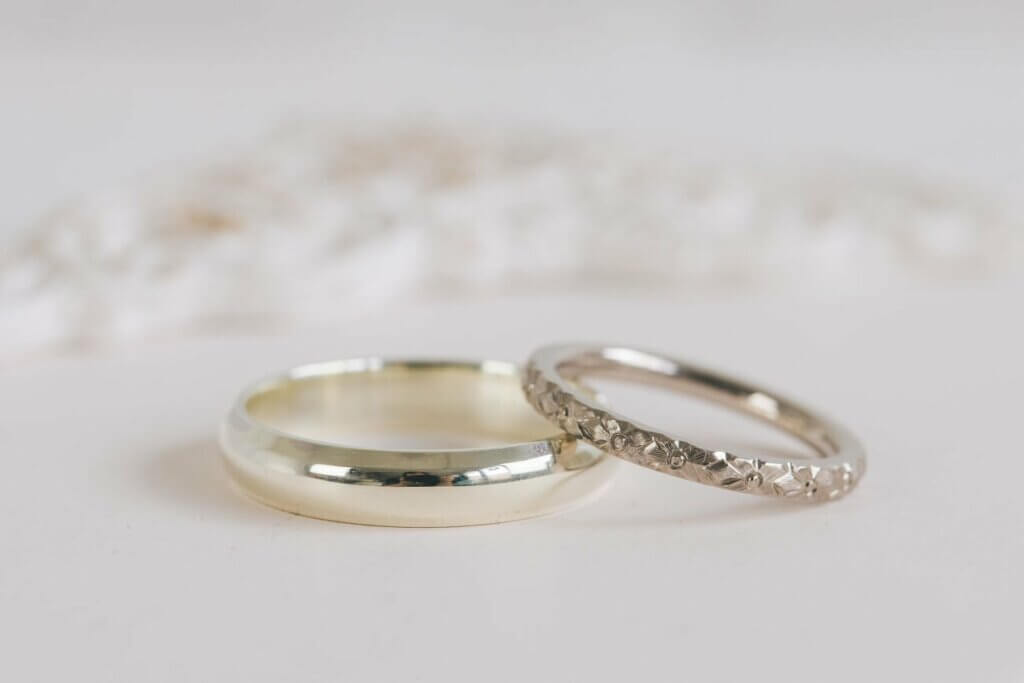
So to conclude…
In my opinion, white gold should be left in its natural state. But most importantly, I think the consumer should be given the choice to plate it and they should most definitely have the opportunity to see it in its natural form without the plating. Who knows, more people might learn to love the warmer, darker colours of un-plated white gold like I do!
Leaving white gold au naturel would give more of a rainbow choice of white precious metals when it comes to bespoke jewellery. Clients can select which metal suits their skin tone; the colour of any stones included in the design, and of course, their budget.
I believe that everyone should have the option to make their own decisions on plating rather than it being thrust on them as a matter of course. There is simply not enough education available to general public on the high street and it frustrates me that so many people are left feeling negatively towards the jewellery industry. They may feel they have been deceived when the plating on their jewellery starts to wear and the true colour of the metal is slowly revealed. I say let’s move away from this bling-tastic culture and let’s give consumers the right to make their own decisions based on the facts.
How do you feel about Rhodium plating?
I’d love to hear your thoughts on the topic below in the comments, and if you’re in the market for a bespoke jewellery design made in natural white gold, do consider getting in touch. I work closely with my clients to design bespoke wedding rings, bespoke engagement rings and all other manner of beautiful jewellery. I can also help remove the rhodium from your existing pieces if you’d like to strip off any remaining rhodium. Get in touch via the contact page to see how I can help.

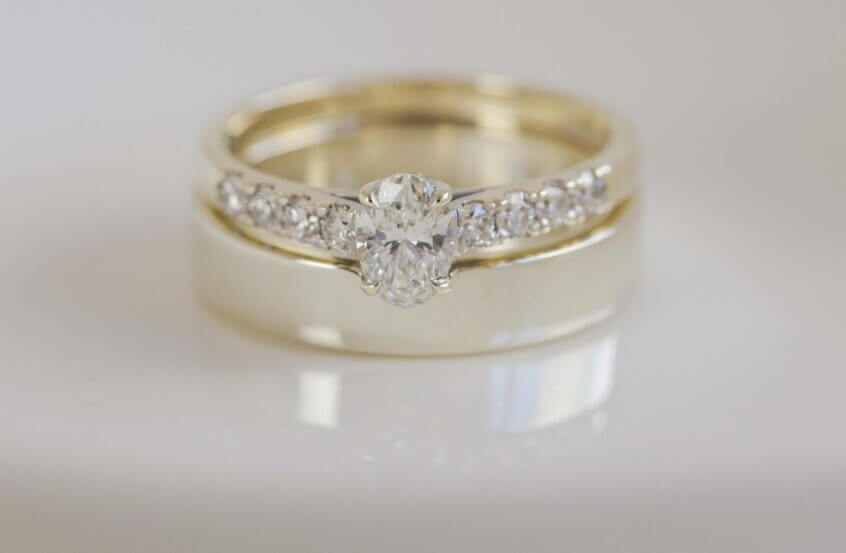
100 Comments on “Why white gold should not be Rhodium plated”
Hi Jodie,
Can you comment on what type of white metal works best for a tension set ring (specifically thinking of an east-west tension setting for an emerald cut stone). I’ve heard of newer alloys sometimes called 19k white or “super white gold”?
Hi, thanks for getting in touch.
For a tension setting, I would recommend going as hard as you can with the metal choice, so probably platinum. However if you like the idea of using non-plated white gold, you could put a hidden support underneath the stone that joins the two shoulders and provides a cup for the stone to sit in, making the setting much stronger (I would do this regardless of metal choice as tension settings are never particularly secure)
As for 19ct gold – this will obviously increase the gold content even further than 18ct so therefore potentially reduce the hardness further.
I hope this helps but let me know if I can help further.
Best wishes,
Jodie
Hi Jodie,
I totally agree with you. I have just had an un-plated, beautiful custom made, hand engraved wedding ring made for me and due to the high quality metal my jeweller uses, the colour is stunning, almost like a creamy silver, which looks perfect with my fair skin!
My question is, if I leave it on for washing hands, sanitising and showering, will it tarnish and end up a yellowy colour, or will it always have the look it has now?
Hi Karen,
Thank you for getting in touch, it’s always nice to hear about people’s experiences with unplated white gold and to hear that other people like it as much as me!
Gold will not tarnish like silver does. As there is no plating, the ring is the exact same colour all the way through so as it wears, it won’t change colour (unlike plated gold). It will just loose its high shine and gain a dull sheen instead.
You are fine to wear it while showering and washing your hands but I’d recommend you take it off for washing up or any activities that might damage it as gold is fairly soft.
I hope this helps – I’d love to see a picture of your ring, it sounds beautiful!
Kind regards,
Jodie
Hi Jodie!
It is just perfect. Different engravings all around it. The man is a genius! If you’d like to see more of Andrew’s work, he’s based in Durham and has a page on facebook called ‘The Croft Workshops’ I encourage you to check him out – his work is fantastic and I would recommend him to anyone looking for bespoke jewellery.
I have attached a couple of pics of my ring from the front and the back.
Karen x https://uploads.disquscdn.com/images/db86b4dbcb73b6d20819cd6a11b99670f862512e2e0136abcd27a4599d088f85.jpg https://uploads.disquscdn.com/images/749330dde2d62ffd07cd8203248ed90459ee9b79a63a312338c6014448be174a.jpg
That’s beautiful Karen! And it suits being natural and unplated – good choice!
Thank you so much! ?
Hi Karen,
Love your ring. Good choice
Susana
Non-rhodium plating looks better (on UK non-nickel material certainly) on 18ct white gold than 9ct IMO. This is because, almost counterintuitively, the 18ct alloys appear whiter, or certainly less yellow than the 9ct!
Why counterintuitive . . . because although there is more yellow gold in the 18ct, typically a higher percentage of palladium is used to whiten it, whereas in the cheaper 9ct alloys, which are potentially more ‘whtenable’ than 18ct, because of less yellow metal in the alloy, typically use less palladium because they are made down to a price.
Hi Adrian, yes it does seem counterintuitive doesn’t it, you’re completely right. I believe this is because the mix of alloys in the mix of 18ct white gold have a more bleaching effect on the gold.
I recently bought a ring in unplated 14k white gold and I have never seen white gold unplated. It truly is better in my opinion too. I attached a pic of my wedding ring and my Masonic ring side by side to show the difference. I loved the article! https://uploads.disquscdn.com/images/c921baa4cca369866f2a681ac3e2a9c48940fbb37993f03d12f85b8c39589568.jpg
Thank you very much Dean and thanks for showing the pictures of your rings – the difference is amazing isn’t it!
This is a topic that is near to my heart…
Cheers! Where are your contact details though?
Thanks Mia! Click here to contact me 🙂
Hallo
Can you please help me and answer this:
Is an Italian 18ct White Gold FOPE necklace alloyed with palladium or silver?
Thank You
Hi William,
I am not sure if the Italian alloy mix is different to the ones used in the UK, but it is usually a mix of silver and palladium, not just one or the other.
I hope this helps!
Best wishes,
Jodie
I wish I had known this before I got my ring. I have to have it plated twice a year to maintain the color. I would actually prefer to have it unplated. Is it possible to remove the plating so it doesn’t just wear off unevenly?
Hi Lea, it is such a common misconception that white gold has to be rhodium plated. It can be polished off, which is something we can help you with should you wish
I also prefer the unplayed white gold.
My wedding set made by friends 17 years ago are unplated 18ct. I took them into a different jeweler (I live in diff state now) for sizing and fusing the 3 bands and the woman at the counter had the funniest look on her face when I said I did not want them to be plated. Like she’s never heard of that before.
I love the character my rings develop over time. And the color is warm. I love au naturel!
It’s so funny the reaction you get from traditional jewellers! I’d so glad you enjoy the natural colour of your rings, I really love it too.
Hi Jodie, I wish I knew about this before I thought they all had to be plated my ring looks terrible now and needs to be replated.
The rhodium can be polished off so you can enjoy the natural colour of the metal – it’s when the rhodium wears off in patches that it doesn’t look great.
How much would it cost to get the plating removed?
Hi Gemma,
It would be great to see a few photos of the jewellery you’d like the plating stripped from and then I can organise a quote for you. If you’d like to send some photos to [email protected], we’d love to help you.
Best wishes,
Jodie
There is definately a lot to know about this topic.
I really like all the points you have made.
Very good information. Lucky me I found your site by accident (stumbleupon).
I’ve book marked it for later!
Thank you so much!
Before reading this post, I had no idea what white gold was. I completely agree with you, and it should not be plated in rhodium. Natural materials age more gracefully. It’s critical to keep the original colour. Thank you, I feel this has been an eye-opener for all of us.
Thank you for your kind comments – I am so glad it was eye opening for you and that you feel the same 🙂 who needs rhodium plating!?
Hi Jodie
I’m so glad I stumbled across your site (which I’ve bookmarked) and this post!
We have found the wedding rings we want locally here; the standard version is 18ct hammered white gold, rhodium-plated, with 18ct yellow gold either side, total width 5.5 mm. We will have it made with with 18ct rose gold instead of the yellow gold, and we can have the white gold without plating (why plate it if it’s hammered anyway?!).
The supplier is finding out whether the ring can be made in palladium instead of white gold. I’m sort of hoping the answer is “no”, because it would save us having to make what is proving to be an impossible decision! We’re “of an age” and it’s second time around for both of us, but we spend a lot of time on the sea; we love the warmth of the rose gold and want the white metal to blend. Taking account of durability etc., is it worth worrying about the palladium option, or is white gold likely to have sufficient longevity if we look after it (obv taking the rings off for DIY etc.)?
(Sadly we probably have neither the time nor the budget for completely custom made)
Thanks a million in advance for your generosity of advice!
Hi Emma,
Thank you for your very kind words, I am pleased to be able to help.
Palladium is more hard wearing than 18ct white gold, but with care, it’ll last a lifetime so I wouldn’t worry. Ultimately, all precious metals are by their very nature soft in order for a goldsmith to be able to work with the metal, so even Palladium will end up with an aged patina with wear. I say embrace it, and enjoy the natural warmth of the white gold next to the rose gold – its my favourite combination 🙂 Here are some we’ve made –
https://www.jodiegearing.com/gallery/wedding-eternity-rings/?mgi_441=15202/his-mixed-gold-wedding-ring-and-her-pave-set-wedding-ring
https://www.jodiegearing.com/gallery/wedding-eternity-rings/?mgi_441=18132/18ct-white-and-rose-gold-wedding-rings
Thank you for your comment and I wish you all the best for your upcoming wedding.
Best wishes,
Jodie
This is a really interesting article and full of information. I would not like my jewellery to be plated however my wedding ring is too small for me now and needs resizing. It is over 40 years old and 18ct white gold. When it is resized will they plate it so you cannot see the join where the put the extra gold in?
Hi Val,
resizes usually happen at the back of the band, so if there was a slight colour difference between the original white gold and the insert of new gold (which is likely, but will be subtle) it would be at the back of the ring. Most jewellers would recommend you plate the ring to cover this colour difference, but it is totally your choice. We recently resized a gents wedding ring and stripped all the rhodium off and you really had to look hard to find the resize area. I hope this helps!
Best wishes,
Jodie
I don’t suppose you know if a white gold wedding ring bought in 2002 in the UK would have been plated originally. (It was a cheap one bought from Argos if that helps)
Hi Michaela, I’m yet to see a high street jeweller offer un-plated white gold, so I am sure it would have been originally.
This is such an interesting article, I’m so glad I found it.
I was on the point of stumping up the money to have my engagement, wedding and eternity rings re-set in platinum as I was so frustrated with how quickly the plating fades, but now I’ll look into having the plating removed. I love the idea of them in their natural 18ct white gold state.
Thanks so much for putting this information out there Jodie!
Hi Sally, thank you for your comment! I am so pleased you found it interesting and that it’s given you the idea to go au natural with your white gold! We can help you with this if you’d like to send me a message via the contact page.
Great reply. I was also thinking along the lines as Sally above but was quoted £3,000 to have my rings remade in platinum. I’ve just come back from the jewellers and she suggested polishing off the plating to avoid the issue in future. We’ve come to the agreement that if I don’t like it, I don’t need to pay for the polishing and would just need to pay to have them replated again. I guess she was pretty confident that I’m going to like them!
So lovely to hear of another jeweller who is offering this service! I hope you love them in their natural colour 🙂 let me know how you get on
Hello Jodie
I’ve just bought a beautiful Vera Wang love ring channel set with diamonds and two sapphires in memory of my mum and dad who I recently lost. It cost 4k and is 18CT white gold. I bought it from my favourite jewellers Earnest Jones. To make it a unique piece I wanted the finish to be Ice Matt. I set about researching how to achieve the finish and re finished the ring myself by hand. Until reading your article I was going to have it rhodium plated to make the effect pop, as it were. I’ve now changed my mind and think it’s more stunning the way it is and will age beautiful as I do! Thank you so much for the advice and making me fall in love with my ring even more!
It’s inspired me to take some jewellery making courses and hopefully one day I’ll be able to create my own stunning natural white gold ring xx
Hi Lee, I am so glad my article has been so helpful! I’d love to see a photo of the finished ring and share any jewellery you make on the courses!
Hi Jodie
Here’s my lovely ring. I polished the plating off very gently and I created a soft matt finish. It’s now creating it’s own finish with natural wear and tear, which I love! It looked awful every time the rhodium plating got scratched or bumped.
https://photos.app.goo.gl/oHpiG3Lg4E5mMVou5
Hi Lee, thank you so much for sharing! It looks great! And the natural patina it will collect over time will be stunning.
I’m a jeweler and designer for over 50 . The reason white gold is rhodium is to give a better and reach look , otherwise white gold looks like steel.
Hi Guido, thanks for sharing your view – it is such a personal thing and some people prefer the bright white of platinum/rhodium plating, but I just believe that people should be shown the natural colour and have a choice is all 🙂
I think this post proved that your are my best friend
My white gold ring has been worn 3wks and is already showing a yellow tint. I wear all the time but rarely even get it wet. Can soldering a wedding to engagement cause this?
Hi Connie, that is unusually fast and would suggest the coating was very thin. If it has recently been soldered to your engagement ring, it should have been plated after the soldering, so therefore should be extra thick! May be worth having a chat with the goldsmith who did this for you. The natural colour of the white gold next to the remaining rhodium plating will look very yellow in comparison, but once it all wears off, it will just look like a darker, gun metal type white instead of polished steel like the rhodium plating. If you don’t want the maintenance of plating, perhaps have it polished off and see if you like the natural colour? If you don’t like it, it can always be plated again! I hope this helps 🙂
Hello!
I did rhodium plate my wedding ring once, I thought it should be done to protect my white gold, you answered my questions, thank you!
Any advice how to clean white gold the best way?
Mostly I go to my jewelry store and they do it…
Thank you ☺️
Hi Elizabeth,
Glad to have helped clear that up! There is so much confusion and misinformation out there 🙂
I pop my rings in an ultrasonic cleaner from time to time to gently vibrate any muck and grime out of the settings. An easy way to replicate the effects at home is to pop your rings into a mug of luke warm water with a little washing up liquid and leave them to soak for a little while. Then scrub them gently with a very soft baby’s toothbrush (behind any settings in particular) and rinse thoroughly. They come up very shiny! Try not to get your rings re-polished by a jeweller too often as metal will be lost each time, so you eventually make your rings thinner by over-polishing.
Let me know how you get on!
Best wishes,
Jodie
Pingback: what makes white gold white-Answerjournal.net
Usually!
Useful post! I really need this type of article.. this is very useful for me.
Plating? We don’t need no stinking plating! Another thing we don’t need is having to pay More for unplated white gold?!
Excellent article. Very interesting to read. I really love to read such a nice article. Thanks! keep rocking
Love your article. Just starting to work with 14k white gold. This really solved my dilemma around plating!
Thanks Tina! What have you decided? I am very close to deciding to stop offering plating for white gold I think!
Hey!
I have a white gold engagement ring which us starting to turn yellow. I wondered if I could plate it with platinum instead of rhodium?
Thanks
Hi Sadé,
Thanks for your comment – you probably could find someone to plate it with platinum, but rhodium is the same family of metals as platinum and looks the same, but is actually harder wearing. The natural colour of the white gold will look yellow in comparison to the remaining rhodium plating, but if you were to get the rhodium polished and the white gold polished up bright, it would look white and then wouldn’t need any further maintenance.
I hope this helps!
Best wishes,
Jodie
Hi! Thanks for responding – much appreciated.
So if I plate it with platinum, it should stay white over time, or are you saying it will still turn yellow eventually? I am trying to decide whether or not to get platinum plating going forward or continue with the rhodium.
I am only feeling this way as I feel I have to plate it a lot in the year, which starts to add up over time 🙁
Thanks
Sadé
Hi Sadé,
All plating will wear off over time, especially on a ring due to the wear and tear they receive. Rhodium is actually harder than platinum so in theory would wear less quickly than platinum. I would persevere with the rhodium, or go natural and have a jeweller polish off the rhodium to embrace the natural colour of the gold. When polished up, it doesn’t look so yellow. Alternatively, have it remade in platinum – by the time you add up the re-plating, this may work out a similar cost over time! And you can always sell the gold for scrap to go towards it and reuse the original stones.
I hope this helps!
Best wishes,
Jodie
Hi Jodie,
Thanks so much for responding!
So are you saying even when I plate the white gold ring with platinum, it will still turn yellow? I am trying to decide if I should start platinum plating or continue with rhodium plating. I am only considering as I have to plate my ring quite often, so the money is adding up lol.
I look forward to your response,
Thanks again,
Sadé
Hi Jodie,
Thanks for your information!
I am considering buying a vintage 9ct white gold ring that I love as my wedding ring but I can see there is some spots of yellowing. I honestly don’t mind that much but was wondering if there was anything I could do to make it look a bit nicer as the (assumed) plating fades away?
Is this just a case of getting a jeweller to remove more of the plating so that its a more even warmer gold?
I’m also a mixed metals person so don’t mind if it has a warmer hue, I just enjoy the more faded appearance of white gold. The ring also has a 1.2 green sapphire on it so the softer metal compliments a little more than a yellow tone.
Thanks in advance for any advice you might have!
Hi Elly, You can get the rhodium polished off so it is not patchy. It sounds divine with the green sapphire!
Hi Jodie, loved you article.
I have a question about posible metal toxicities specifically from a chemical reaction to worn down rhodium on a ring worn everyday doing hot outdoor labor exposing the white gold and probably nickel (being in the US). Can the chemical compounds of the rhodium plating seep into the skin causing a reaction when mixed with our natural salty sweat or any other non natural substances? Or after the rhodium has worn away completely can an allergic reaction to the nickel linger on well after the ring has been removed?
Hi Jennifer, thank you for your comment and I am so pleased you like the article. Rhodium is a chemically inert metal so the rhodium won’t be causing any issues, but the nickel that may be present certainly could be if the plating has worn away. I would imagine if a reaction has occurred, the effects would linger until the skin recovers/renews. I hope this helps!
Hi Jodie,
I recently purchased a vintage 13g sturdy unplateded white gold ring with yellow gold carved details on side and 12mm bezel set oval synthetic blue sapphire on top of ring. Would it be possible to remove the oval sapphire and replace with a 10-12mm round diamond instead and new bezel. I too much prefer white gold without rhodium so I’ll be retaining old patina which gives character. I appreciate any advice you can offer. Cheers, Michael
Hi Michael,
Thank you for getting in touch. It sounds like a fantastic ring and a lovely upgrade idea – please email me some photos and I can advise further: [email protected]
I look forward to hearing from you.
Best wishes,
Jodie
Hi again Jodie,
Well , a bit of a development with the saga of the white gold sapphire ring. I was in town earlier today where my jeweller lives here in Ireland, so after reading your articles on remodelling etc.. I popped in to shop and explained to him about possibility of removing the oval synthetic sapphire and replacing with the round diamond and if he could design a new bezel to receive the new stone. The jeweller decided to accept the challenge and explained he would have to add gold to the head of the ring on both corners to turn oval to a circle and then build up a new bezel, if that makes any sense ! So , I shouldn’t be too long waiting to find out If its a success or not.
I was determined to to put the round diamond I already had into a really sturdy safe setting as the ring it was in just didn’t seem secure and was not precious metal rather jewellers bronze I think. Although it’s not a very valuable diamond it is earth mined ,so I thought it deserved to be in a nice setting as well as maybe bringing me good luck in terms of benefit of wearing a
natural stone according to vedic astrology. So , just to say thanks again Jodie for your inspiring articles and expert advice which highlights the pleasure of recreating something new out of an old or vintage design that then gets a new lease of life.
Kind regards,
Michael.
Did a lot of research when designing my wife and my wedding rings. I liked the warmer tone of the 14 white gold for mine on 18 yellow, where we went for a 19 white for my wifes, the colour was almost rhodium. I was concerned about the hardness, but the jeweller was kind enough to provide the alloy specs from his dealer for me to look at. Turned out the 19 was harder than my 14, lot more expensive though too. Still went way within our budgets to skip the engagement rings and get custom wedding rings.
That’s great! Win win 🙂 I’d love to see a photo of your rings!
This is such an interesting article, very eye opening. I was looking to have my wedding ring plated in rhodium again because it got resized and now there is a yellow patch on the back. Now I am thinking I should have my wedding, engagement and eternity ring polished back to their natural state. My question is will it look okay considering the engagement ring is white gold 750 and the wedding and eternity bands are white gold 585? Will they have different amounts of yellow or maybe they will all tone in together?
Hi Kayla,
Thank you for your comment – I am so pleased you found the article interesting!
There would be a very slight colour difference between the two qualities of gold, but once both are polished up, you’d have to really look to notice it. This image shows the colour difference very accurately – http://cdn-2.abudhabi2.com/wp-content/uploads/2015/09/Types-of-Gold.jpg
What you might find is that the area that has been resized on your wedding ring may vary from the rest of the ring and you have a slightly different tone at the back of your ring. This is due to each batch of white gold is going to vary from the previous slightly -they rarely exactly match. I have this on the back of my wedding ring and it doesn’t bother me, but just something to bear in mind.
Also – the rings would be polished up prior to being re-plated with rhodium anyway, therefore removing the remaining rhodium, so perhaps have them polished up and see what you think. They can always be plated if you change your mind.
I hope this helps 🙂
Best wishes,
Jodie
Hi Jodie,
Thank you for this post. This is the only one out of many that I’ve read that satisfied my decision between 14k and 18k.
What’s your opinion of buffing a platinum engagement ring at home following the contents of this video? https://www.youtube.com/watch?v=1a48NmcLQgo
I do like the bright white look but I like more the idea of not having to take it in for servicing and am now considering a platinum shank — if I can do the buffing at home. (I’m set on a platinum crown and the shank will be a simple 2mm metal band with potentially milgrain on the inside circle of the shank.) I know it sounds a little scary and of course buffing/polishing platinum should be left to professionals — do you think it can be done at home without fatality to the ring? 😀
Best,
Celeste
Hi Celeste,
Thank you for your comment and I am glad that it helped you decide on which gold you prefer.
I would not recommend polishing your ring at home using any method. Polishing is a very skilled craft in its own right and over-polishing or repeated polishing firstly can compromise settings and the detail and shape of the ring, and each polish removes material from the ring and therefore thins it out. It is not something you want to do too often. Polishing can be very dangerous – if a ring hits the wheel at the wrong angle, it can be pulled out of your hand and shot across the room or even into you!
I know shiny new rings look amazing, but there is a grace and beauty to the gradual patina of life impressing on jewellery as well.
A simple rub with a polishing cloth after a dunk in an ultrasonic cleaner brings up jewellery very nicely, and is much safer to do at home.
I hope this helps!
Best wishes,
Jodie
Hi Jodie,
Great article and wished I’d seen it before. My beautiful white gold wedding ring must have nickel in it as 2 years in and I can no longer wear it due to a terrible skin reaction. I’ve been advised to have the rhodium plating done but after reading your article I’m hoping you have better advice?
Thanks, Lee
Hi Lee, Oh no, what a shame! I find that during the winter, I get redness and sore, dry skin around my rings due to the winter changes and constant hand washing – I try to remember to remove my rings when I wash my hands and thoroughly dry them as that helps keep it at bay. Is it possible you’re experiencing the same as me rather an allergic reaction? If you’re ring was bought in the UK by a UK supplier, there should not be any nickel present in the alloy.
And how would you compare Palladium to Rhodium?
Hi Robert, Palladium was a great option when it originally received its hallmark. It gave the bright white colour of platinum permanently (unlike rhodium plating on top of white gold which wears away), but the price has since sky rocketed and Palladium is now more expensive than platinum, which means its just not a viable choice anymore unfortunately!
Hii!
So are you saying even when I plate the white gold ring with platinum, it will still turn yellow? I am trying to decide if I should start platinum plating or continue with rhodium plating. I am only considering it as I have to plate my ring quite often, so the money is adding up lol.
Thanks x
Hi Sade,
Platinum is not as hard wearing as rhodium, so if you want to keep plating, I would stick with rhodium. The natural white gold will look more yellow next to the remaining rhodium plating than it would if it was polished up. Maybe try having it professionally polished to see the real colour before you decide? Or get a quote to have the ring re-made in platinum – the ongoing cost of plating will soon add to having it made in a new metal!
I hope this helps
Jodie x
Hello Jodie,
What a wonderful find your site was. I wish more jewellers could or would talk as knowledgeably as you have.
I always wore yellow gold jewellery until I reached a certain age and went from blond hair to white! I found I needed to rethink the colours I wore and also decided I now suited the whiter metals next to my hair and face.
I have a question about a 9ct white gold pendant which has been engraved.
I’ve worn it regularly for four years and there has been no noticeable change in the soft but definitely white colour.
Then suddenly it turned a very definite and even yellow, not quite as yellow as my other yellow gold items but definitely no longer white. The chain (bought separately is still the original whiter colour)
The only thing I can attribute the sudden change to, is the fact that I went on a two week swimming course and was in a chlorinated pool most days, and I foolishly was unaware of the effect chlorine could have.
I did some research and found out that chlorine can remove the rhodium. But further enquiries with the online jeweller I got it from resulted in me learning that their white gold items are not rhodium plated!
Does this mean that the white gold alloy itself has reacted to the chlorine? The colour change is very even which is why I suspect immersion in the water rather than wear.
Hi Marjory,
Thank you so much for your kind words! I am so pleased you found my website informative. There is so much misinformation out there about white gold, so it’s nice to clear it up and spread the truth!
The chain is most likely rhodium plated, but if the pendant was not originally, the alloys within the gold may have reacted badly to the chlorine. White gold alloys are usually silver or palladium, or a combination of the two. Silver can react quite dramatically to chlorine, so this may be the case in your pendant.
If you have a jewellery cleaning/polishing cloth, try giving it a buff to see if it brings back the whiter colour. Or ask a local jeweller to polish it professionally for you.
Please let me know how you get on.
Best wishes,
Jodie
My husband got me a wedding set that he paid over $3k for they started turning yellow before a year. I was very upset when the jeweler told me about the rhodium issue, I told him they should advise the customer of this as I would have made a different choice had I known.
Hi Sheila, I can completely sympathise with your upset. I do believe it is wrong that rhodium plated white gold jewellery is sold without a conversation about the maintenance. The natural white gold will look very yellow next to the remaining rhodium, but if you have it professionally polished off, it will just look like a darker white, and then no more maintenance. I hope in time you can learn to love the natural colour and can find someone local to you to polish off the rhodium.
Hi. My husband recently bought me a beautiful anniversary setting with a zircon as the center stone. I have purchased a diamond and am ready to have it set in the ring. After reading this I am hesitant to proceed as a local jeweler (with excellent reviews) informed me that the ring will be rhodium plated after the stone is changed out. I am concerned about constant maintenance as this happened to me with a necklace I had repaired once. It eventually wears and needs replating. Also the ring has a lot of fine detail work in it. Won’t that be worn away after years of replating? Is there any way to work on the ring without needing to replate it? I also am not sure if it already has plating on it from when it was purchased. I was under the impression that once you work on a piece of jewelry it will always need replating. I notice that the necklace I mentioned turns black in spots and needs to be plated every so often. Just not sure how to get the new stone in the ring without altering it or needing maintenance going forward. Can you advise? Thank you for this great article.
Hi Lili,
Thank you for your kind words about the article, I’m glad you found it helpful. You are absolutely correct – repeated rhodium plating means repeated polishing and therefore the fine detail is at risk of being worn down. It’s not like layers of paint on intricate wood or metal work – the detail is not lost under layers of plating, but because it has to be cleaned and polished prior to plating and this causes wear. It is most likely the ring is rhodium plated as this is the standard thing for most jewellers to do.
Because it has been plated once does not mean it has to be plated again – I often remove rhodium plating for customers and they embrace the natural tone, with no further maintenance required.
The current plating can be polished off, and then it won’t need polishing again if you want to have it in its natural form.
One thing to consider is that white gold alloys vary a lot, so any work/resizes can be slightly noticeable (if you look hard). I have 18ct white gold engagement and wedding rings (obviously with no rhodium!) – they have all had resizes at the back of the band and if you look very closely, you can see some colour difference, but you do have to look for it. Rhodium plating obviously covers this. Platinum is more consistent so any work done on the ring is invisible.
I haven’t experienced any blackness on white gold myself – perhaps it has a high copper/silver content that is oxidising? If so, this can be buffed off with a standard jewellery polishing cloth.
I hope this helps, please let me know how you get on!
Thank you so much for that very detailed and informative response. I do so appreciate this information. Just wondering…since the center stone is set higher than the halo around it in my ring, would it be possible to rhodium plate the prongs ONLY after the center stone is changed out? I’m trying to avoid redipping the whole ring and I’m not sure I trust anyone to remove the rhodium. I’d like to change the center stone but am trying to avoid anything else done to the ring including rhodium plating or removal. Do I have options or does the entire ring need to be redipped or stripped after changing the center stone? Thank you again for your time and informative advice.
Hi Lili,
No problem at all, happy to help. There is a method to just partially plate an item using a special pen tool, but I’m not aware of anyone I can recommend for this. Perhaps the goldsmith helping you with the stone swap might be able to do this?
A master goldsmith would do a great job at removing the rhodium whilst not spoiling the intricate detail of the ring. If you go this route, it only has to be polished once. If you keep the rhodium, it will need to be repeatedly polished prior to re-plating to keep the ring looking its best, and therefore the intricate detail is at risk of being polished away. I’m guessing this is a ring you want to wear frequently so the rhodium plating (especially on the high points of the ring) will wear fairly quickly and need re-doing.
Let me know what you decide to do!
Love your manufacturing information about ring manufacture process. I love the color, style, stone of every ring that your share. But I personally like the green rings.
Hi David,
Thank you for your comment – I’m glad there are so many people who love the natural colour of white gold as I do 🙂
Best wishes,
Jodie
This has really opened my eyes for me! I was completely unaware of the factors to take into account while applying rhodium plating to white gold jewelry. Through reading your post, I was able to have a better understanding of the reasoning behind it as well as an appreciation for the inherent beauty of white gold. It is crucial for people who are passionate about jewelry to be informed, and your blog does a fantastic job of serving this objective.
Hi Jodie,
I’m so happy to see you still replying to folks on this phenomenal article! It’s been a real help while designing my engagement ring.
I’m planning on getting my ring made with unplated palladium white gold (I’m in the US, and want it to be nickel-free). I love the warm, almost gold, not quite silver look that unplayed white gold offers.
My question is: would 14k palladium white gold or 18k palladium white gold have a warmer, yellowery tone to it (which is what I want?)?
In the post made by “Adrian” in 2018, they mention how, couterintuitively, 9k white gold has a warmer tone than white gold with a higher gold content. Is that true between 14k and 18k?
Thanks in advance for your any help you can give me!
Hi Bethany,
Thank you for your lovely comment! So happy I have been able to help you with planning your engagement ring.
This article includes a good image of natural white gold including 14 and 18k palladium white gold: https://www.diamondguide.org/different-colors-of-gold-jewelry/
9ct is a pale creamy colour whereas 18ct is a darker more gunmetal tone.
Best wishes,
Jodie
Rhodium plating white gold can enhance its appearance by giving it a bright, reflective surface. However, I appreciate the point you’ve raised in this blog post. Choosing not to rhodium plate can be an eco-conscious decision as it avoids the need for re-plating, reducing chemical waste. Additionally, some people prefer the natural warmth of non-plated white gold. It’s an interesting perspective on a commonly practiced jewelry technique.
Thank you for your comment Lucy. I would argue that polished white gold without the rhodium plating is also bright and reflective. The plating doesn’t affect the reflective nature of it, but just gives it a cold white appearance instead of a warm white.
Hi Jodie
Absolutely loved your article and advice. I was thinking about replating my 14K white gold and diamond channel set wedding band that has yellowed over the years. After reading your article I have decided not to. Thank you!
My husband’s wedding band is a plain 14K white gold band. Over the years he has developed an allergic type reaction causing his skin under the ring to become irritated and peel. Especially if he wears it for an extended period of time. From reading your article I’m guessing it’s the nickel in the metal. I was thinking about replacing it with a platinum ring. Any advice on how to remedy this issue?
Hi Veronica,
I am so glad I have helped you fall in love with your now natural white gold set, that’s so lovely to hear!
I am assuming you are in the US? US white gold does have varying levels of nickel in it, so it could be a reaction to the nickel, or a reaction to any water or soap getting under the ring – this happens to me. I have to have ring breaks from time to time to clear it up.
Platinum is a good replacement if it is a reaction to nickel as you can be assured there will be no nickel content.
Let me know how you get on!
Best wishes,
Jodie
Thanks for this. I recently had my white gold wedding and engagement rings (which were custom made) resized (first time since 1997). I let the jeweler polish them (again – first time), but resisted the rhodium plating which was somewhat pushed. Glad I did.
This is fantastic! I am so glad you are enjoying the natural colour now, and well done for pushing back against the traditional jewellers who did the work for you. We will gradually spread the word and make natural white gold more common!